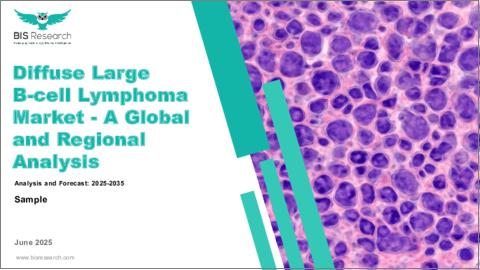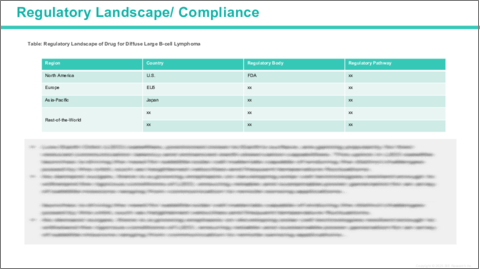|
|
市場調査レポート
商品コード
1753875
びまん性大細胞型B細胞リンパ腫市場:世界および地域別の分析・予測 (2025-2035年)Diffuse Large B-cell Lymphoma Market - A Global and Regional Analysis: Analysis and Forecast, 2025-2035 |
||||||
カスタマイズ可能
|
|||||||
| びまん性大細胞型B細胞リンパ腫市場:世界および地域別の分析・予測 (2025-2035年) |
|
出版日: 2025年06月23日
発行: BIS Research
ページ情報: 英文 100 Pages
納期: 1~5営業日
|
全表示
- 概要
- 図表
- 目次
びまん性大細胞型B細胞リンパ腫 (DLBCL) 市場の主な促進要因の一つは、標的療法、特にCAR-T細胞療法や二重特異性抗体などの免疫療法の進歩です。
これらの治療法は、再発または難治性のびまん性大細胞型B細胞リンパ腫の治療に革命をもたらし、以前は利用できなかった非常に効果的で個別化された治療選択肢を提供しています。YescartaやKymriahのようなCAR-T細胞療法は、従来の化学療法が無効であった患者の長期寛解達成に顕著な成功を示しており、患者の転帰と生存率を大幅に改善しています。
免疫療法の可能性に対する認識の高まりに加え、遺伝子検査やバイオマーカープロファイリングの進歩が、患者の腫瘍の個別的特徴に合わせた、より精密な治療オプションへの需要を促進しています。これらの進展は、生存率の改善だけでなく、従来の化学療法に伴う副作用の軽減にも貢献しており、DLBCL市場をさらに推進する重要な要因となっています。
さらに、特に高齢化社会における非ホジキンリンパ腫 (NHL) の有病率の増加が、高度な治療オプションに対する需要の高まりに寄与しています。診断ツールの改善により、より多くの患者が早期段階で診断されるようになったため、DLBCL治療の市場は急速に拡大しており、製薬企業が革新的な治療法を開発・商業化する機会を生み出しています。
DLBCL市場の成長しているにもかかわらず、その潜在力を完全に発揮することを妨げるいくつかの課題が依然として存在しています。主要な課題のひとつは、治療費の高さであり、特に、CAR-T細胞療法や二重特異性抗体などの先進的な治療法は高額であることが多く、特に中低所得国ではすべての患者が治療を受けられるとは限りません。これらの治療費はヘルスケアシステムに大きな負担となり、最も革新的な治療法への患者のアクセスを制限します。
もう一つの課題は、治療抵抗性と再発です。CAR-T療法やその他の標的治療は、再発または難治性のびまん性大細胞型B細胞リンパ腫の治療において目覚ましい成果を示していますが、一部の患者では依然として治療失敗や疾患の再発が見られます。このことは、継続的な技術革新と、耐性を克服し、より持続的な奏効をもたらす新たな治療法の開発の必要性を浮き彫りにしています。
さらに、CAR-T療法に関連するサイトカイン放出症候群 (CRS) や神経毒性などの副作用も懸念事項です。これらの副作用は適切なモニタリングとケアによって管理可能であるものの、専門的な医療インフラが必要であり、特に設備の整っていない医療環境では普及の障害となる可能性があります。
診断の遅れも依然として継続的な課題です。多くのDLBCL症例は進行期で診断されることが多く、それによって治療効果が制限されます。症状の多くがより侵攻性の低い他の疾患と重複しているため、介入を遅らせており、早期発見は依然として重要なハードルとなっています。
最後に、分子プロファイリングや遺伝子マーカーに基づいた個別化治療の複雑さも課題です。精密医療は大きな可能性を秘めている一方で、検査の利用可能性や腫瘍の異質性 (ヘテロジェネイティ) の理解不足などの問題があり、常に適切な治療を適切な患者に適合させることを困難にしています。
当レポートでは、世界のびまん性大細胞型B細胞リンパ腫 (DLBCL) の市場を調査し、主要動向、市場影響因子の分析、法規制環境、臨床試験の分析、市場規模の推移・予測、各種区分・地域/主要国別の詳細分析、競合情勢、主要企業のプロファイルなどをまとめています。
目次
エグゼクティブサマリー
第1章 世界のびまん性大細胞型B細胞リンパ腫市場:業界展望
- 市場動向
- 規制の枠組み
- 疫学分析
- 臨床試験分析
- 市場力学
- 影響分析
- 市場促進要因
- 市場の課題
- 市場機会
第2章 びまん性大細胞型B細胞リンパ腫の世界市場:地域別
- 北米
- 主な調査結果
- 市場力学
- 市場規模・予測
- 欧州
- 主な調査結果
- 市場力学
- 市場規模・予測
- アジア太平洋
- 主な調査結果
- 市場力学
- 市場規模・予測
第3章 世界のびまん性大細胞型B細胞リンパ腫市場:競合情勢と企業プロファイル
- 主要戦略と開発
- M&A
- 相乗効果のある活動
- 事業拡大と資金調達
- 製品の発売と承認
- その他の活動
- 企業プロファイル
- AbbVie Inc.
- Merck KGaA
- F. Hoffmann-La Roche AG
- Johnson & Johnson (Janssen Pharmaceuticals, Inc.)
- Denovo Biopharma, Inc.
- Calithera Biosciences, Inc.
- Biogen Inc.
- Autolus Therapeutics plc
- Allogene Therapeutics, Inc.
- Novartis AG
- Miltenyi Biomedicine GmbH
- Regeneron Pharmaceuticals, Inc.
- Debiopharm International SA
- Seagen Inc.
- Takeda Pharmaceutical Company Limited
第4章 調査手法
List of Figures
- Figure: Global Diffuse Large B-cell Lymphoma Market (by Region), $Billion, 2024 and 2035
- Figure: Global Diffuse Large B-cell Lymphoma Market Key Trends, Analysis
List of Tables
- Table: Global Diffuse Large B-cell Lymphoma Market Dynamics, Impact Analysis
- Table: Global Diffuse Large B-cell Lymphoma Market (by Region), $Billion, 2024-2035
Global Diffuse Large B-cell Lymphoma Market, Analysis and Forecast: 2025-2035
Diffuse Large B-cell Lymphoma (DLBCL) is an aggressive and most common form of non-Hodgkin lymphoma (NHL), a cancer that originates in the lymphatic system, which is part of the body's immune system. Diffuse Large B-cell Lymphoma is characterized by the rapid and uncontrolled growth of large B-cells, a type of white blood cell that plays a key role in immune response by producing antibodies. These abnormal B-cells grow in a diffuse pattern, meaning they spread throughout the affected tissue, often involving lymph nodes, spleen, bone marrow, and other organs.
Diffuse Large B-cell Lymphoma typically presents as a fast-growing tumor, and the symptoms can vary depending on the area affected, but common symptoms include swollen lymph nodes, fever, night sweats, unexplained weight loss, and fatigue. If untreated, Diffuse Large B-cell Lymphoma can rapidly progress and affect vital organs, which can lead to organ failure.
Diffuse Large B-cell Lymphoma is most diagnosed in adults, particularly those over the age of 60, but it can also occur in younger individuals. Diagnosis is typically confirmed through biopsy of the affected lymph node or tissue, followed by immunohistochemistry and genetic tests to assess the characteristics of the lymphoma cells.
The treatment for diffuse Large B-cell Lymphoma typically includes chemotherapy (such as R-CHOP, which combines Rituximab with chemotherapy drugs) and immunotherapy. In cases where the disease is resistant to treatment or recurs, CAR-T cell therapy and bispecific antibodies are emerging as effective options.
With prompt diagnosis and treatment, many patients with Diffuse Large B-cell Lymphoma can achieve remission, but the disease remains aggressive, and early intervention is crucial for improving survival outcomes.
One of the key drivers of the Diffuse Large B-cell Lymphoma (DLBCL) market is the advancement in targeted therapies, particularly immunotherapies like CAR-T cell therapy and bispecific antibodies. These therapies are revolutionizing the treatment of relapsed or refractory diffuse Large B-cell Lymphoma, offering highly effective and personalized treatment options that were previously unavailable. CAR-T cell therapies such as Yescarta and Kymriah have shown remarkable success in achieving long-term remission in patients who have failed conventional chemotherapy, significantly improving patient outcomes and survival rates.
The growing recognition of immunotherapy's potential, combined with advancements in genetic testing and biomarker profiling, is driving the demand for more precise treatment options tailored to the individual characteristics of patients' tumors. These advancements are not only improving survival rates but also reducing the side effects associated with traditional chemotherapy, which remains a critical factor in driving the Diffuse Large B-cell Lymphoma market forward.
Furthermore, the increasing prevalence of non-Hodgkin lymphoma (NHL), especially in the aging population, is contributing to the rising demand for advanced treatment options. As more patients are diagnosed at earlier stages due to improved diagnostic tools, the Diffuse Large B-cell Lymphoma market for Diffuse Large B-cell Lymphoma therapies is expanding rapidly, creating opportunities for pharmaceutical companies to develop and commercialize innovative treatments.
Despite the growth of the Diffuse Large B-cell Lymphoma (DLBCL) market, several challenges continue to impede its full potential. One of the primary challenges in Diffuse Large B-cell Lymphoma market is the high cost of treatment, particularly with advanced therapies like CAR-T cell therapy and bispecific antibodies, which are often expensive and may not be accessible to all patients, especially in low- and middle-income countries. The cost of these therapies places a significant burden on healthcare systems and limits patient access to the most innovative treatment options.
Another challenge is treatment resistance and relapse. While CAR-T therapies and other targeted treatments have shown impressive results in treating relapsed or refractory Diffuse Large B-cell Lymphoma, a subset of patients still experience treatment failure or disease recurrence. This highlights the need for continuous innovation and the development of additional therapies that can overcome resistance and provide more durable responses.
Additionally, side effects from treatments, including cytokine release syndrome (CRS) and neurological toxicities associated with CAR-T therapies, remain a concern. Although these side effects are manageable with proper monitoring and care, they require specialized healthcare infrastructure, which can be a barrier to widespread adoption, especially in less-equipped healthcare settings.
Late diagnosis is another ongoing issue, as many Diffuse Large B-cell Lymphoma cases are diagnosed at advanced stages, limiting the effectiveness of treatment. Early detection remains a significant hurdle, as many of the symptoms overlap with other, less aggressive conditions, delaying intervention.
Finally, the complexity of personalized treatment based on molecular profiling and genetic markers presents challenges. While precision medicine offers significant potential, there are issues related to the availability of testing and the understanding of tumor heterogeneity, making it difficult to always match the right treatment to the right patient.
Diffuse Large B-cell Lymphoma market challenges highlight the need for continued innovation, affordable access, and better healthcare infrastructure to fully realize the potential of Diffuse Large B-cell Lymphoma treatments and improve patient outcomes.
The global Diffuse Large B-cell Lymphoma (DLBCL) market is highly competitive, with several key players driving innovation and market growth. Leading companies such as AbbVie Inc. (Genmab A/S), Merck KGaA, F. Hoffmann-La Roche AG, and Johnson & Johnson (Janssen Pharmaceuticals, Inc.) are at the forefront, developing cutting-edge therapies to address the unmet needs of Diffuse Large B-cell Lymphoma patients. These companies are focusing on novel treatment approaches like CAR-T cell therapies, bispecific antibodies, and monoclonal antibodies that are showing significant promise in improving patient outcomes, particularly in relapsed or refractory cases. Additionally, companies like Biogen Inc., Novartis AG, and Regeneron Pharmaceuticals, Inc. are investing heavily in immunotherapies and targeted treatments, which are reshaping the treatment landscape and expanding the scope for long-term remission and improved survival rates. The ongoing research and strategic partnerships within these companies are driving continued advancements in the Diffuse Large B-cell Lymphoma market, contributing to a growing demand for more personalized, effective, and less toxic treatment options. As the Diffuse Large B-cell Lymphoma market continues to evolve, these leaders remain integral in providing innovative therapies for better management of Diffuse Large B-cell Lymphoma.
Diffuse Large B-cell Lymphoma Market Segmentation:
Segmentation 1: by Region
- North America
- Europe
- Asia-Pacific
The global Diffuse Large B-cell Lymphoma (DLBCL) market is experiencing several key emerging trends that are reshaping the landscape of diagnosis, treatment, and patient care. One of the most significant trends in Diffuse Large B-cell Lymphoma market is the increasing focus on immunotherapy, particularly CAR-T cell therapy and bispecific antibodies. These therapies represent a shift towards targeted and personalized treatments, offering improved efficacy in relapsed or refractory Diffuse Large B-cell Lymphoma cases where traditional chemotherapy has often failed. CAR-T therapies, such as Yescarta and Kymriah, are showing promising results in inducing long-term remissions and are becoming an integral part of the Diffuse Large B-cell Lymphoma treatment landscape.
Another emerging trend is the growing emphasis on combination therapies, where immunotherapy is used in conjunction with chemotherapy or other targeted therapies. This approach aims to enhance treatment effectiveness by addressing multiple pathways that contribute to disease progression. Bispecific antibodies like epcoritamab, which target both CD3 on T-cells and CD20 on B-cells, are gaining momentum due to their ability to more effectively engage the immune system and directly target lymphoma cells.
Additionally, the focus on personalized medicine is reshaping the treatment approach for Diffuse Large B-cell Lymphoma. Advances in genetic profiling and biomarker testing are allowing clinicians to better understand the molecular characteristics of individual patients' tumors, enabling the selection of therapies tailored to the specific needs of the patient. This trend towards precision medicine is leading to more effective and less toxic treatments, improving patient outcomes.
Table of Contents
Executive Summary
Scope and Definition
Market/Product Definition
Inclusion and Exclusion
Key Questions Answered
Analysis and Forecast Note
1. Global Diffuse Large B-cell Lymphoma Market: Industry Outlook
- 1.1 Introduction
- 1.2 Market Trends
- 1.3 Regulatory Framework
- 1.4 Epidemiology Analysis
- 1.5 Clinical Trial Analysis
- 1.6 Market Dynamics
- 1.6.1 Impact Analysis
- 1.6.2 Market Drivers
- 1.6.3 Market Challenges
- 1.6.4 Market Opportunities
2. Global Diffuse Large B-cell Lymphoma Market (Region), ($Billion), 2023-2035
- 2.1 North America
- 2.1.1 Key Findings
- 2.1.2 Market Dynamics
- 2.1.3 Market Sizing and Forecast
- 2.1.3.1 North America Diffuse Large B-cell Lymphoma Market, by Country
- 2.1.3.1.1 U.S.
- 2.1.3.1 North America Diffuse Large B-cell Lymphoma Market, by Country
- 2.2 Europe
- 2.2.1 Key Findings
- 2.2.2 Market Dynamics
- 2.2.3 Market Sizing and Forecast
- 2.2.3.1 Europe Diffuse Large B-cell Lymphoma Market, by Country
- 2.2.3.1.1 Germany
- 2.2.3.1.2 U.K.
- 2.2.3.1.3 France
- 2.2.3.1.4 Italy
- 2.2.3.1 Europe Diffuse Large B-cell Lymphoma Market, by Country
- 2.3 Asia Pacific
- 2.3.1 Key Findings
- 2.3.2 Market Dynamics
- 2.3.3 Market Sizing and Forecast
- 2.3.3.1 Asia Pacific Diffuse Large B-cell Lymphoma Market, by Country
- 2.3.3.1.1 China
- 2.3.3.1.2 Japan
- 2.3.3.1 Asia Pacific Diffuse Large B-cell Lymphoma Market, by Country
3. Global Diffuse Large B-cell Lymphoma Market: Competitive Landscape and Company Profiles
- 3.1 Key Strategies and Development
- 3.1.1 Mergers and Acquisitions
- 3.1.2 Synergistic Activities
- 3.1.3 Business Expansions and Funding
- 3.1.4 Product Launches and Approvals
- 3.1.5 Other Activities
- 3.2 Company Profiles
- 3.2.1 AbbVie Inc.
- 3.2.1.1 Overview
- 3.2.1.2 Top Products / Product Portfolio
- 3.2.1.3 Top Competitors
- 3.2.1.4 Target Customers/End-Users
- 3.2.1.5 Key Personnel
- 3.2.1.6 Analyst View
- 3.2.2 Merck KGaA
- 3.2.2.1 Overview
- 3.2.2.2 Top Products / Product Portfolio
- 3.2.2.3 Top Competitors
- 3.2.2.4 Target Customers/End-Users
- 3.2.2.5 Key Personnel
- 3.2.2.6 Analyst View
- 3.2.3 F. Hoffmann-La Roche AG
- 3.2.3.1 Overview
- 3.2.3.2 Top Products / Product Portfolio
- 3.2.3.3 Top Competitors
- 3.2.3.4 Target Customers/End-Users
- 3.2.3.5 Key Personnel
- 3.2.3.6 Analyst View
- 3.2.4 Johnson & Johnson (Janssen Pharmaceuticals, Inc.)
- 3.2.4.1 Overview
- 3.2.4.2 Top Products / Product Portfolio
- 3.2.4.3 Top Competitors
- 3.2.4.4 Target Customers/End-Users
- 3.2.4.5 Key Personnel
- 3.2.4.6 Analyst View
- 3.2.5 Denovo Biopharma, Inc.
- 3.2.5.1 Overview
- 3.2.5.2 Top Products / Product Portfolio
- 3.2.5.3 Top Competitors
- 3.2.5.4 Target Customers/End-Users
- 3.2.5.5 Key Personnel
- 3.2.5.6 Analyst View
- 3.2.6 Calithera Biosciences, Inc.
- 3.2.6.1 Overview
- 3.2.6.2 Top Products / Product Portfolio
- 3.2.6.3 Top Competitors
- 3.2.6.4 Target Customers/End-Users
- 3.2.6.5 Key Personnel
- 3.2.6.6 Analyst View
- 3.2.7 Biogen Inc.
- 3.2.7.1 Overview
- 3.2.7.2 Top Products / Product Portfolio
- 3.2.7.3 Top Competitors
- 3.2.7.4 Target Customers/End-Users
- 3.2.7.5 Key Personnel
- 3.2.7.6 Analyst View
- 3.2.8 Autolus Therapeutics plc
- 3.2.8.1 Overview
- 3.2.8.2 Top Products / Product Portfolio
- 3.2.8.3 Top Competitors
- 3.2.8.4 Target Customers/End-Users
- 3.2.8.5 Key Personnel
- 3.2.8.6 Analyst View
- 3.2.9 Allogene Therapeutics, Inc.
- 3.2.9.1 Overview
- 3.2.9.2 Top Products / Product Portfolio
- 3.2.9.3 Top Competitors
- 3.2.9.4 Target Customers/End-Users
- 3.2.9.5 Key Personnel
- 3.2.9.6 Analyst View
- 3.2.10 Novartis AG
- 3.2.10.1 Overview
- 3.2.10.2 Top Products / Product Portfolio
- 3.2.10.3 Top Competitors
- 3.2.10.4 Target Customers/End-Users
- 3.2.10.5 Key Personnel
- 3.2.10.6 Analyst View
- 3.2.11 Miltenyi Biomedicine GmbH
- 3.2.11.1 Overview
- 3.2.11.2 Top Products / Product Portfolio
- 3.2.11.3 Top Competitors
- 3.2.11.4 Target Customers/End-Users
- 3.2.11.5 Key Personnel
- 3.2.11.6 Analyst View
- 3.2.12 Regeneron Pharmaceuticals, Inc.
- 3.2.12.1 Overview
- 3.2.12.2 Top Products / Product Portfolio
- 3.2.12.3 Top Competitors
- 3.2.12.4 Target Customers/End-Users
- 3.2.12.5 Key Personnel
- 3.2.12.6 Analyst View
- 3.2.13 Debiopharm International SA
- 3.2.13.1 Overview
- 3.2.13.2 Top Products / Product Portfolio
- 3.2.13.3 Top Competitors
- 3.2.13.4 Target Customers/End-Users
- 3.2.13.5 Key Personnel
- 3.2.13.6 Analyst View
- 3.2.14 Seagen Inc.
- 3.2.14.1 Overview
- 3.2.14.2 Top Products / Product Portfolio
- 3.2.14.3 Top Competitors
- 3.2.14.4 Target Customers/End-Users
- 3.2.14.5 Key Personnel
- 3.2.14.6 Analyst View
- 3.2.15 Takeda Pharmaceutical Company Limited
- 3.2.15.1 Overview
- 3.2.15.2 Top Products / Product Portfolio
- 3.2.15.3 Top Competitors
- 3.2.15.4 Target Customers/End-Users
- 3.2.15.5 Key Personnel
- 3.2.15.6 Analyst View
- 3.2.1 AbbVie Inc.






